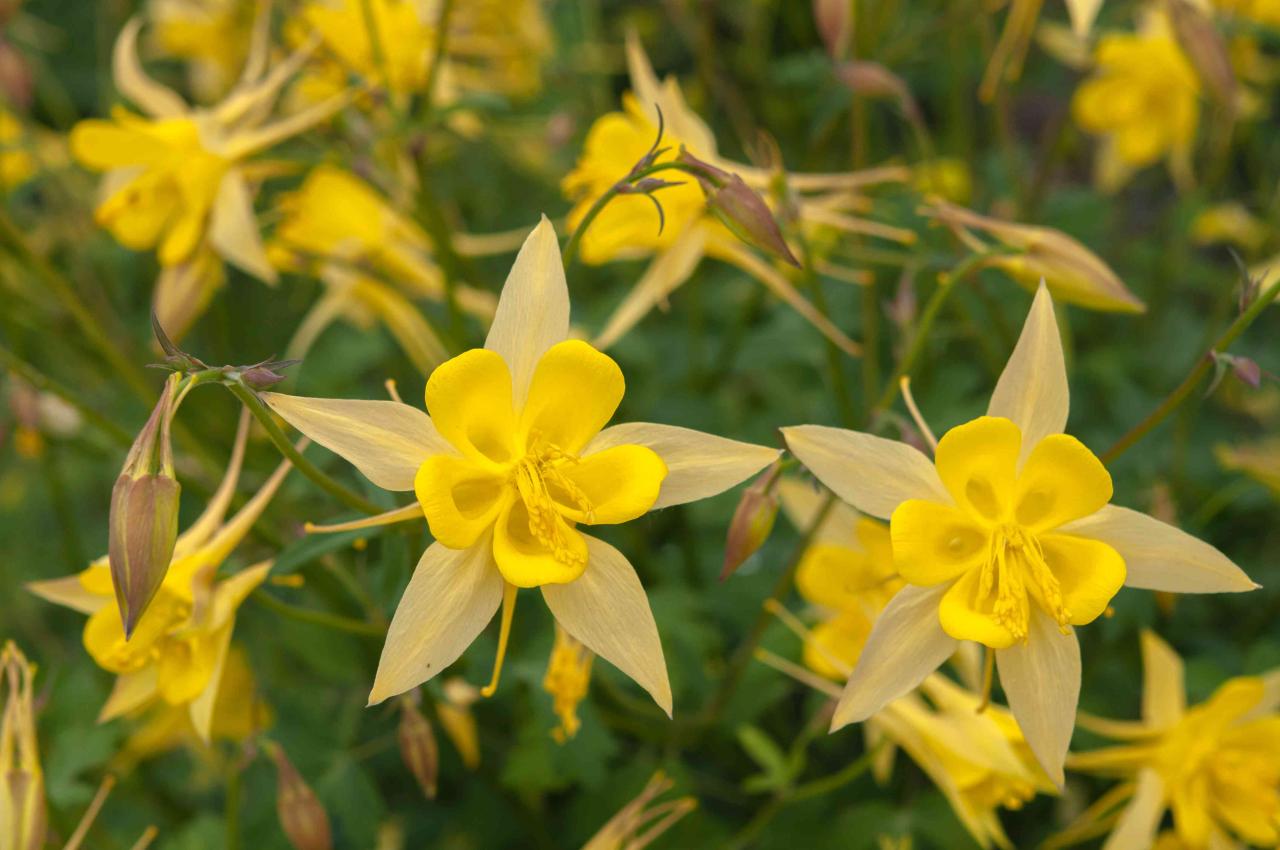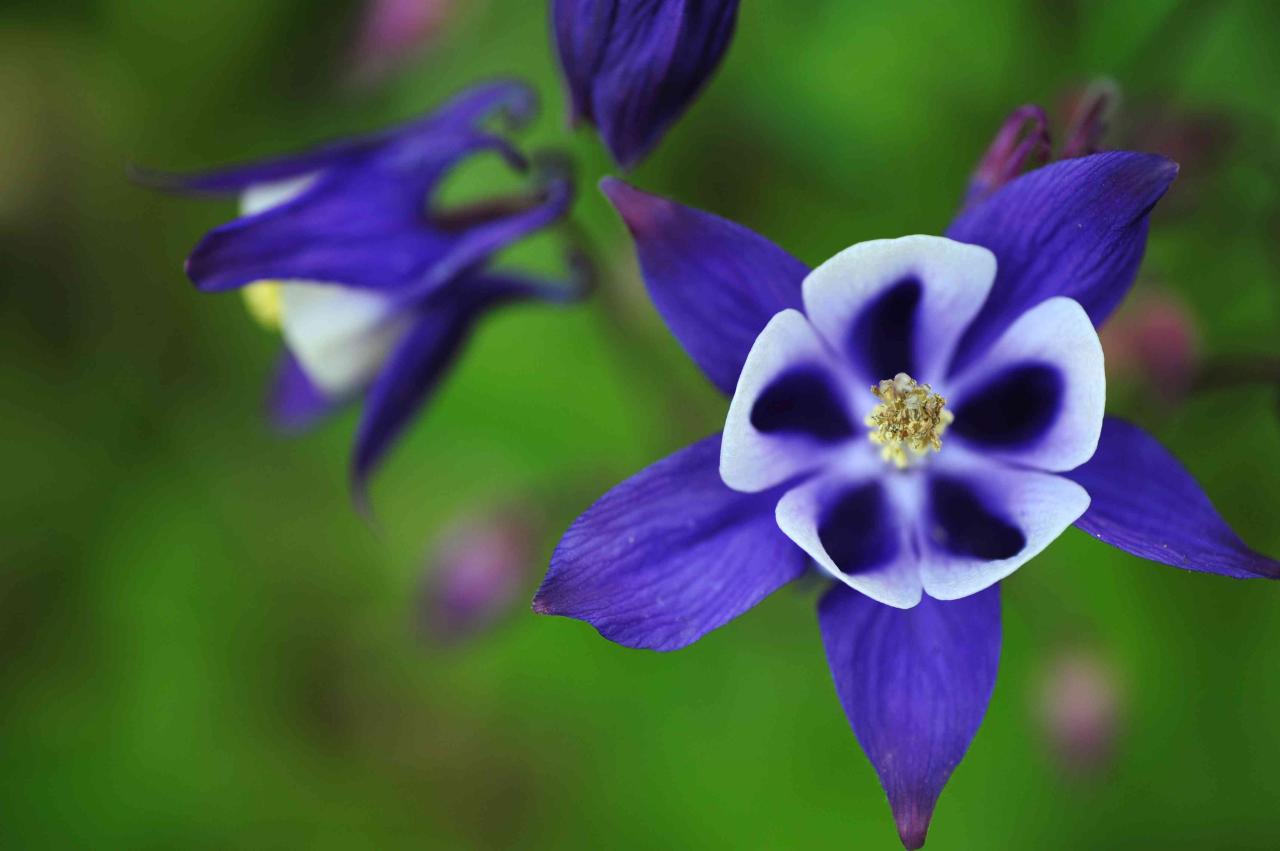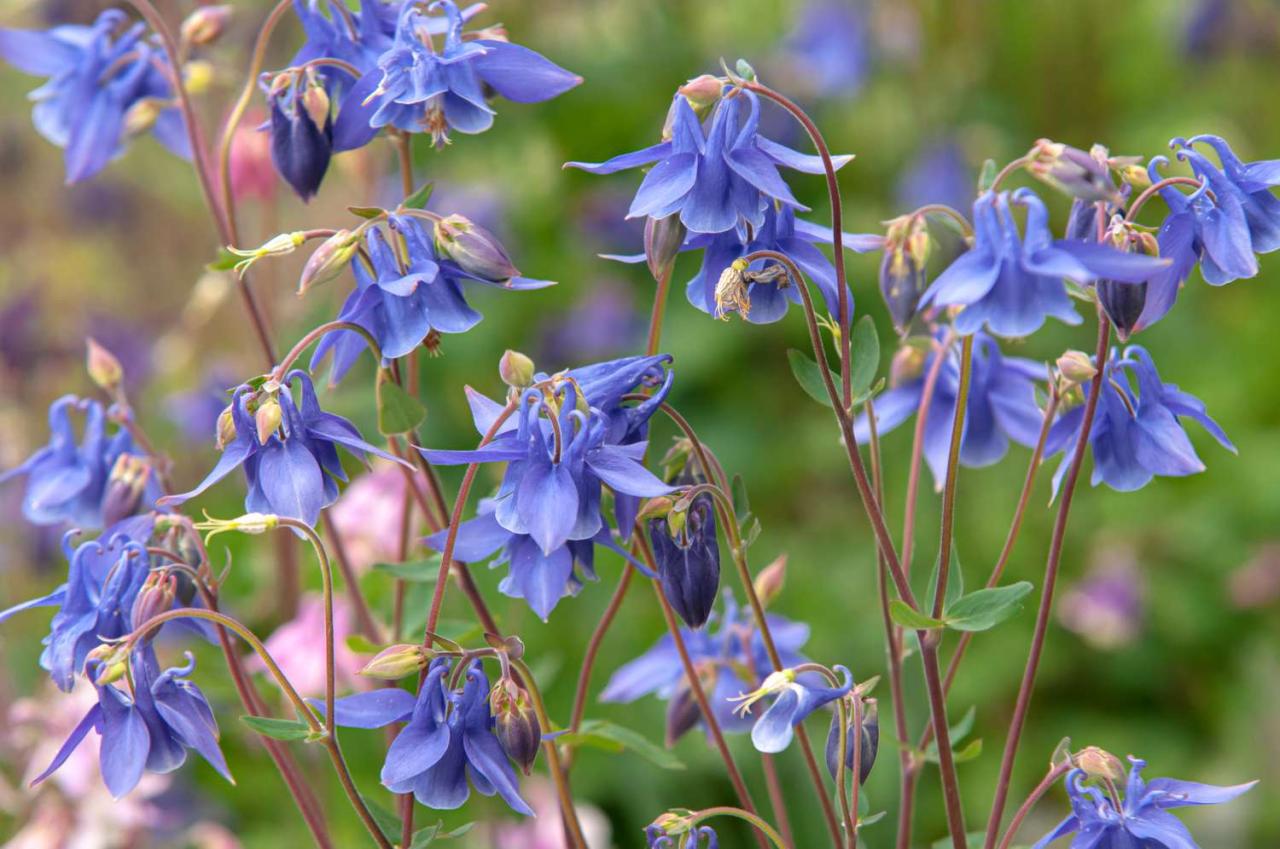The Benefits of Adding Columbine Plants to Your Garden are numerous, offering a blend of beauty, ecological value, and practicality. These delicate, bell-shaped flowers, with their captivating colors and intricate patterns, are a welcome addition to any garden, attracting pollinators, supporting biodiversity, and adding a touch of charm to your landscape.
Columbine, a genus of flowering plants belonging to the Ranunculaceae family, boasts a rich history and cultural significance. Their vibrant colors, ranging from deep blues and purples to soft pinks and yellows, create a stunning visual spectacle. From their origins in the temperate regions of the Northern Hemisphere, these plants have been prized for their beauty and medicinal properties for centuries.
The Allure of Columbine

Columbine plants, with their delicate, bell-shaped flowers and intricate foliage, have captivated gardeners and nature enthusiasts for centuries. These enchanting blooms, often associated with grace and elegance, add a touch of whimsy and charm to any garden setting. Columbine plants are members of the genusAquilegia*, which encompasses a wide array of species and cultivars, each boasting unique characteristics.
Their vibrant colors range from classic blues and purples to bold reds, yellows, and even bi-colored combinations.
Columbine plants offer a vibrant splash of color and delicate beauty to any garden, attracting hummingbirds and butterflies with their nectar-rich blooms. To create a stunning display, consider the techniques outlined in How to Achieve a Stunning Columbine Plant Garden.
With proper care, these enchanting plants will reward you with their graceful presence and add a touch of natural charm to your outdoor space.
Origins and Cultural Relevance
The name “columbine” is derived from the Latin wordcolumba*, meaning “dove,” a reference to the flower’s resemblance to a group of doves clustered together. These plants have a rich history, with origins tracing back to ancient civilizations. In Greek mythology, columbine was believed to be the flower of Aphrodite, the goddess of love and beauty.
Columbine plants hold cultural significance in various traditions. In Victorian language of flowers, they symbolize “foolishness” or “anxious anticipation.” In some cultures, columbine is associated with the Holy Spirit, while others view it as a symbol of hope and renewal.
Ecological Benefits of Columbine
Columbine plants, with their vibrant colors and delicate blooms, are more than just aesthetically pleasing additions to your garden. They are also valuable contributors to a thriving ecosystem, playing a vital role in supporting biodiversity and natural pest control.
Attracting Pollinators
Columbine’s unique, tubular-shaped flowers are a beacon for pollinators, particularly bees and butterflies. These flowers provide a rich source of nectar and pollen, essential for these beneficial insects to thrive.
“Columbine’s flowers are particularly attractive to bumblebees, which are known for their role in pollinating a wide range of plants.”
- The flowers’ deep, nectar-filled spurs are accessible only to insects with long tongues, such as bumblebees, which helps ensure efficient pollination.
- Columbine blooms throughout the spring and summer, providing a continuous source of food for pollinators during a crucial period.
Enhancing Biodiversity, The Benefits of Adding Columbine Plants to Your Garden
By attracting pollinators and providing habitat for other beneficial insects, columbine contributes to a more diverse and vibrant garden ecosystem. This diversity helps to create a more resilient and balanced garden, reducing the risk of pest outbreaks and disease.
- Columbine’s foliage provides shelter for beneficial insects, such as ladybugs and lacewings, which prey on garden pests.
- The presence of a variety of plants, including columbine, creates a more complex and interconnected ecosystem, which is less susceptible to disruptions.
Supporting Natural Pest Control
Columbine’s ability to attract beneficial insects, like ladybugs and lacewings, helps to naturally control pests in the garden. These insects feed on aphids, caterpillars, and other common garden pests, reducing the need for chemical pesticides.
Columbine plants are a beautiful addition to any garden, offering delicate blooms and attractive foliage. They are also known to attract pollinators, which is a crucial aspect of maintaining a healthy ecosystem. If you’re looking for a more dramatic statement, consider adding some Rodgers plants to your landscape.
Transform Your Space with These Stunning Rodgers Plant Varieties offers a comprehensive guide to these magnificent plants, highlighting their unique features and how they can elevate your garden’s aesthetic appeal. Columbine plants, however, are low-maintenance and adaptable, making them an excellent choice for gardeners of all experience levels.
- Columbine’s foliage provides shelter for beneficial insects, allowing them to establish populations in the garden.
- The presence of pollinators also helps to attract birds, which further contribute to pest control by feeding on insects.
Growing Columbine

Columbine plants are relatively easy to grow, making them an excellent choice for both experienced and novice gardeners. Whether you choose to start with seeds or seedlings, a few key steps will ensure your columbine thrives in your garden.
Planting Columbine Seeds
Starting columbine from seed offers a rewarding experience, allowing you to witness the entire growth process. Here’s how to sow columbine seeds successfully:
- Choose the Right Time:Columbine seeds can be sown directly in the garden in early spring or late summer. For a head start, you can start seeds indoors about 6-8 weeks before the last frost.
- Prepare the Soil:Columbine prefers well-drained soil that is slightly acidic. Amend the soil with compost or peat moss to improve its structure and fertility.
- Sow the Seeds:Scatter seeds thinly on the soil surface and lightly cover them with a thin layer of soil. Water gently after planting.
- Provide Adequate Light:Columbine seeds need light to germinate, so don’t cover them too deeply. If starting indoors, place the seed tray under a grow light.
- Maintain Moisture:Keep the soil consistently moist, but avoid overwatering.
- Thin Seedlings:Once seedlings emerge, thin them to about 6-12 inches apart, depending on the variety.
Planting Columbine Seedlings
Purchasing columbine seedlings from a nursery offers a faster way to add these beautiful plants to your garden. Follow these steps for successful planting:
- Select Healthy Seedlings:Look for seedlings with strong stems, healthy leaves, and no signs of disease or pests.
- Prepare the Planting Hole:Dig a hole twice as wide and as deep as the seedling’s root ball.
- Place the Seedling:Gently remove the seedling from its container and loosen the roots slightly. Place the seedling in the hole, ensuring the top of the root ball is level with the soil surface.
- Backfill the Hole:Fill the hole with soil, pressing it gently around the roots to eliminate air pockets.
- Water Thoroughly:Water the newly planted seedling deeply to settle the soil and promote root growth.
Optimal Growing Conditions
Providing the right growing conditions is essential for healthy columbine growth.
- Sunlight:Columbine thrives in partial shade, especially in hot climates. A location with 4-6 hours of sunlight per day is ideal.
- Soil:Well-drained, slightly acidic soil is best for columbine. Adding compost or peat moss to the soil will improve its drainage and fertility.
- Watering:Columbine prefers consistently moist soil, but avoid overwatering, which can lead to root rot. Water deeply once or twice a week, especially during dry periods.
- Fertilization:Columbine is a light feeder and doesn’t require heavy fertilization. A balanced fertilizer applied once or twice during the growing season is sufficient.
Creative Uses of Columbine in Garden Design: The Benefits Of Adding Columbine Plants To Your Garden
Columbine’s delicate, bell-shaped flowers and intricate foliage offer a multitude of possibilities for enhancing garden design. Their versatility allows them to seamlessly blend into various garden styles, from cottage gardens to contemporary landscapes.
Columbine Varieties for Different Garden Styles
Choosing the right columbine variety can significantly enhance the overall aesthetic of your garden. Here’s a table highlighting some popular columbine varieties suitable for different garden styles:
Garden Style |
Columbine Variety |
Description |
|---|---|---|
Cottage Garden |
Aquilegia vulgaris |
Classic columbine with a wide range of colors, perfect for a relaxed, informal setting. |
Formal Garden |
Aquilegia caerulea |
Elegant, blue-flowered columbine with a more structured appearance, ideal for formal gardens. |
Woodland Garden |
Aquilegia canadensis |
Native columbine with red and yellow flowers, thriving in shady woodland settings. |
Rock Garden |
Aquilegia flabellata |
Compact, low-growing columbine suitable for rock gardens and borders. |
Integrating Columbine with Other Flowering Plants
Columbine’s unique flower shape and color palette make it an excellent companion plant for a wide range of flowering species. Here are some examples:
- Cottage Garden:Combine columbine with other cottage garden favorites like lavender, roses, and foxgloves for a whimsical, romantic effect.
- Formal Garden:Pair columbine with irises, peonies, and delphiniums for a more structured and elegant look.
- Woodland Garden:Plant columbine alongside ferns, hostas, and trilliums for a natural, woodland feel.
- Rock Garden:Combine columbine with sedums, alpine phlox, and dwarf conifers for a vibrant, textural display.
Adding Vertical Interest and Texture
Columbine’s upright stems and airy foliage add vertical interest and texture to garden spaces.
- Border Edging:Plant columbine along the edges of borders for a soft, cascading effect.
- Container Gardens:Use columbine in containers to create a layered and textural display.
- Mixed Borders:Interplant columbine with taller plants to create a dynamic and visually appealing composition.
Columbine: Beyond the Garden

Columbine’s allure extends far beyond its delicate beauty and captivating presence in gardens. Throughout history, this plant has been interwoven with human culture, finding its place in traditional medicine, art, literature, and folklore.
Medicinal Properties and Traditional Uses
Columbine has a long history of medicinal use, with its properties valued by various cultures.
- Native Americans utilized columbine for its analgesic and anti-inflammatory properties, employing it to treat a range of ailments, including headaches, toothaches, and skin irritations.
- In Europe, columbine was traditionally used as a sedative and to treat respiratory issues, particularly coughs and bronchitis.
- It is important to note that while columbine possesses potential medicinal benefits, it is essential to exercise caution as some parts of the plant are toxic. Consult a qualified healthcare professional before using columbine for medicinal purposes.
Symbolism in Art and Literature
Columbine’s captivating appearance has inspired artists and writers for centuries, lending itself to diverse interpretations and symbolism.
- In art, columbine often represents humility, gratitude, and the ephemeral nature of beauty. Its delicate, bell-shaped flowers evoke a sense of fragility and grace.
- In literature, columbine is frequently associated with themes of love, loss, and the passage of time. Its vibrant colors and delicate form symbolize the fleeting nature of life and the beauty that exists in the face of adversity.
- One notable example is in Shakespeare’s “A Winter’s Tale,” where columbine is used to represent the character of Perdita, who embodies innocence and natural beauty.
Folklore and Mythology
Columbine holds a prominent place in folklore and mythology, with its unique appearance and symbolism inspiring various tales and beliefs.
- In European folklore, columbine is associated with fairies and elves, who are said to use its flowers as cradles for their babies. This belief reflects the plant’s delicate and enchanting nature.
- In some cultures, columbine is considered a symbol of protection against evil spirits. It is often planted near homes and doorways to ward off misfortune.
- In Greek mythology, columbine is linked to the goddess Aphrodite, who is said to have used the plant to create a potion that enhanced beauty and love. This association highlights the plant’s connection to themes of romance and attraction.
Final Summary
Incorporating columbine into your garden is a rewarding experience, enriching your landscape with vibrant colors, attracting beneficial insects, and offering a glimpse into the fascinating world of nature. Whether you are an experienced gardener or a novice, columbine provides a simple yet effective way to enhance your garden’s beauty and ecological value.
FAQs
Are columbine plants poisonous?
While columbine plants are generally considered safe for gardens, it’s important to note that all parts of the plant are slightly toxic if ingested. Keep children and pets away from the plants and avoid consuming any part of the plant.
How long do columbine flowers last?
Columbine flowers typically bloom for several weeks, from late spring to early summer. You can extend the flowering period by deadheading spent blooms.
Do columbine plants attract hummingbirds?
Yes, columbine flowers are known to attract hummingbirds, particularly those with long beaks, due to their nectar-rich flowers and tubular shape.
